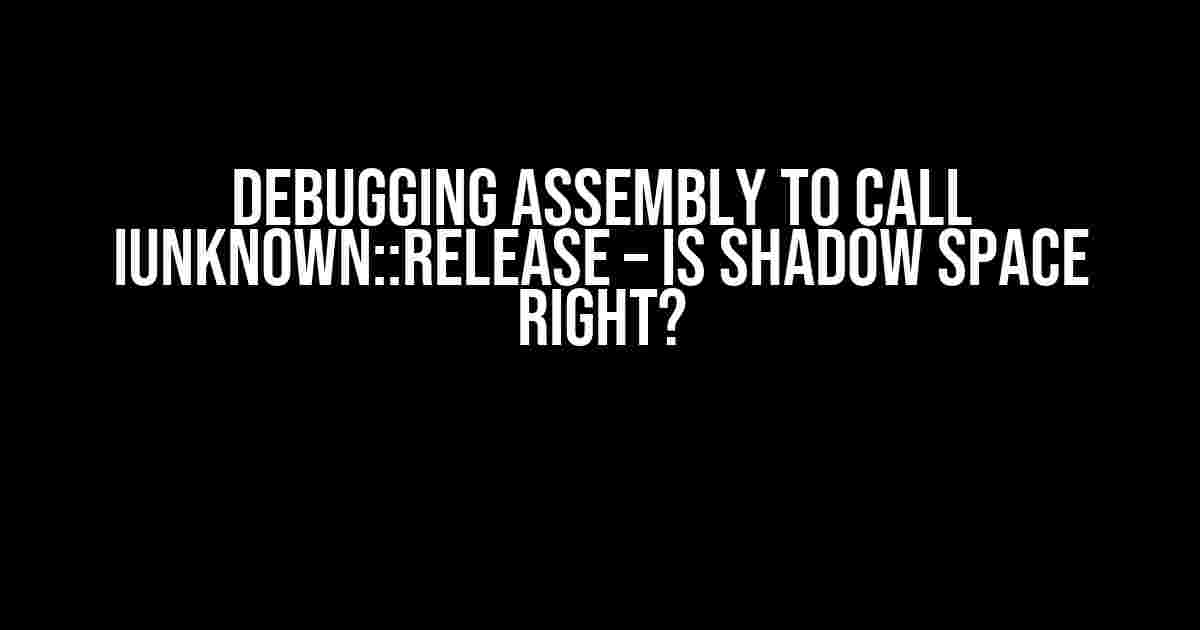Calling IUnknown::Release from assembly code can be a daunting task, especially when it comes to dealing with the intricacies of shadow space. In this article, we’ll delve into the world of low-level programming and explore the concept of shadow space, its importance, and how to correctly call IUnknown::Release from assembly code.
What is Shadow Space?
In the x86-64 architecture, shadow space refers to a region of memory allocated on the stack to store the caller-saved registers and the return address. This space is used to preserve the calling convention and ensure proper parameter passing between functions.
+-----------+ | Return | | Address | +-----------+ | RSI | | RDI | | RCX | | RDX | | R8 | | R9 | +-----------+
The above diagram illustrates the typical layout of shadow space. As you can see, it consists of the return address and the caller-saved registers (RSI, RDI, RCX, RDX, R8, and R9).
Why is Shadow Space Important?
Shadow space plays a crucial role in maintaining the integrity of the call stack. When a function is called, the calling convention requires the caller to allocate space on the stack for the called function’s parameters and return address. This ensures that the called function can access its parameters correctly and return to the correct location.
Failing to allocate shadow space or incorrectly managing it can lead to catastrophic consequences, including:
- Stack corruption
- Parameter passing errors
- Return address corruption
- Crashes and exceptions
Calling IUnknown::Release from Assembly Code
Now that we’ve covered the basics of shadow space, let’s dive into calling IUnknown::Release from assembly code. The IUnknown interface is a fundamental component of COM (Component Object Model), and Release is one of its essential methods.
; assumes RCX contains the pointer to the IUnknown interface mov rax, rcx mov ecx, ecx mov rdx, -1 call [rax] ; Call IUnknown::Release
In the above example, we’re calling IUnknown::Release by:
- Loading the pointer to the IUnknown interface into RCX
- Setting ECX to the same value as RCX (required for the calling convention)
- Setting RDX to -1, which is the parameter for IUnknown::Release
- Calling the method using the indirect call syntax [rax]
However, this code is incomplete and will likely result in errors. Why?
The Missing Piece: Shadow Space
We need to allocate shadow space to ensure proper parameter passing and return address management. Here’s the corrected code:
sub rsp, 40 ; Allocate shadow space mov [rsp+28], rcx ; Store the this pointer mov rax, rcx mov ecx, ecx mov rdx, -1 call [rax] ; Call IUnknown::Release add rsp, 40 ; Deallocate shadow space
By allocating 40 bytes of shadow space (sub rsp, 40), we ensure that the caller-saved registers and return address are preserved. We then store the this pointer (RCX) at the correct location in the shadow space ([rsp+28]).
Table: Shadow Space Layout for x86-64
| Offset | Register/Register Pair |
|---|---|
| 0 | Return Address |
| 8 | RSI |
| 16 | RDI |
| 24 | RCX |
| 32 | RDX |
| 40 | R8 |
| 48 | R9 |
The above table illustrates the typical layout of shadow space for x86-64. Note the offset values, which are used to store the registers and return address.
Conclusion
In this article, we’ve explored the importance of shadow space in low-level programming and demonstrated how to correctly call IUnknown::Release from assembly code. By allocating and managing shadow space correctly, you can ensure that your assembly code interacts correctly with the calling convention and avoids catastrophic errors.
Remember, when working with assembly code, it’s essential to pay attention to the smallest details, including shadow space management. With practice and patience, you’ll become proficient in crafting robust and efficient assembly code that interacts seamlessly with higher-level languages.
Happy coding!
Frequently Asked Question
Unravel the mysteries of debugging assembly to call IUnknown::Release, and shed some light on the shadow space conundrum!
Q1: Why do I need to call IUnknown::Release in assembly code?
Calling IUnknown::Release in assembly code is essential to decrement the reference count of an object, ensuring it’s properly released when no longer needed. This manual intervention is required because the compiler can’t automatically generate the necessary code for COM objects.
Q2: What’s the significance of shadow space in this context?
Shadow space refers to the space on the stack allocated for the This pointer (ECX) and other parameters when calling a COM method. In the case of IUnknown::Release, it’s crucial to reserve the correct shadow space (typically 8 bytes) to ensure the method is called correctly.
Q3: How do I determine the correct shadow space size for IUnknown::Release?
The shadow space size depends on the architecture and the number of parameters. For IUnknown::Release, which takes only the This pointer as an argument, you typically need to reserve 8 bytes (4 bytes for the This pointer and 4 bytes for the return address) on 32-bit platforms and 16 bytes (8 bytes for the This pointer and 8 bytes for the return address) on 64-bit platforms.
Q4: Can I use the `invoke` instruction to call IUnknown::Release?
While the `invoke` instruction can be used to call IUnknown::Release, it’s not recommended as it can lead to incorrect shadow space allocation. Instead, use the `call` instruction with manual shadow space reservation to ensure correct calling convention.
Q5: What are the consequences of incorrect shadow space allocation?
Incorrect shadow space allocation can lead to stack corruption, crashes, or undefined behavior. In the worst-case scenario, it can also cause security vulnerabilities. Therefore, it’s essential to carefully manage the shadow space when calling IUnknown::Release or other COM methods in assembly code.
